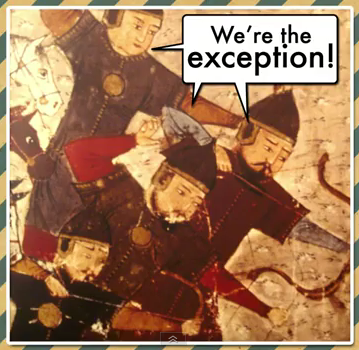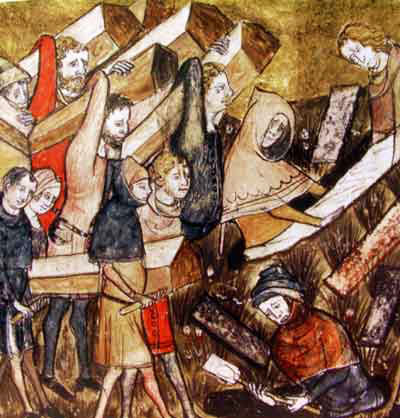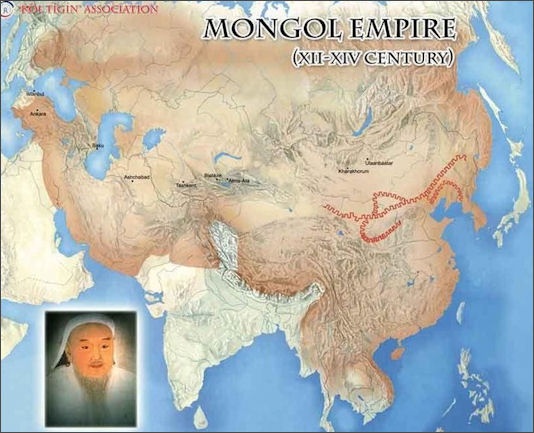
The Mongols: An empire that historians hold a great many opinions about. There is the view of the Mongols as one of the most murderous empire of the post classical era and another that put Mongols under the classification of being one of the most terribly "misunderstood peoples". In actuality, the Mongols were more complex than simply good or evil. They did terrorize their surrounding empires, but, they also made some positive contributions as well.

Expanding territory was a big goal for Mongolia. Creating an empire of people who were united was the point of the Empire in the first place. Mongolia started out in the steppes region above China where the pastoral nomadic people were in a constant state of fighting, both among themselves and with other nomadic tribes. Fed up with the fighting, a poor, father-less boy set out to turn Mongolia into a place of no more fighting.That dream – give or take – did come true. Mongolia did become a very large empire from 1206 to 1368, one that was quite peaceful within their own territory.
 The rise and spread of the Mongolians can be attributed to one man, a poor child who grew up with a widowed mother, Genghis Khan, or Timujin, or Chenghis Khan, whichever one fits your fancy. Having grown up enduring the perils of the warring nomadic tribes, Khan made it his goal to create a Mongolia that wasn't in a constant state of fighting. Once he got some political power, he did just that. Using the tactic of fear, Khan built up Mongolia into a large empire. In doing so he used a great deal of force and terror, genocide playing a big factor in getting citizens to surrender to Mongolian rule, killing villagers who wouldn't back down and enslaving those who did. From a poor child to an emperor who conquered by fear, to a man who is currently genetically related to over 6 million men, Genghis Khan built a Mongolian Empire that would (despite not leaving a solid artefactual footprint) be remembered.
The rise and spread of the Mongolians can be attributed to one man, a poor child who grew up with a widowed mother, Genghis Khan, or Timujin, or Chenghis Khan, whichever one fits your fancy. Having grown up enduring the perils of the warring nomadic tribes, Khan made it his goal to create a Mongolia that wasn't in a constant state of fighting. Once he got some political power, he did just that. Using the tactic of fear, Khan built up Mongolia into a large empire. In doing so he used a great deal of force and terror, genocide playing a big factor in getting citizens to surrender to Mongolian rule, killing villagers who wouldn't back down and enslaving those who did. From a poor child to an emperor who conquered by fear, to a man who is currently genetically related to over 6 million men, Genghis Khan built a Mongolian Empire that would (despite not leaving a solid artefactual footprint) be remembered.
Note: Khan made such a mark in Mongolian history that Mongolia in 2008 decided to make the world's largest statue of his head. The statue sits on top of the Genghis Khan hotel and is 10 meters tall.
 One thing Khan succeeded phenomenally at was creating a powerful military. The Mongols fought bloody and - though small in population - there military manages to gain a reputation for winning. The Mongols took their military duty very seriously, the act of fleeing from mandatory military services was punishable by death. Within the military there were many different ranks, as well as a special rank for those who where part of the army due to their village surrendering to Mongolian rule. In the army women and men shared equal parts, both sexes fighting together with similar weapons, the bow and arrow among the most popular of the weapons, being shot from horseback.
One thing Khan succeeded phenomenally at was creating a powerful military. The Mongols fought bloody and - though small in population - there military manages to gain a reputation for winning. The Mongols took their military duty very seriously, the act of fleeing from mandatory military services was punishable by death. Within the military there were many different ranks, as well as a special rank for those who where part of the army due to their village surrendering to Mongolian rule. In the army women and men shared equal parts, both sexes fighting together with similar weapons, the bow and arrow among the most popular of the weapons, being shot from horseback.
Every Mongol learned to ride a horse at the age of three and were required to join the army from the age of fourteen to twenty-six. The Mongolian military gained a strong upper hand thanks to their system of spies, as well as an inventive list of specific tactics. Mongols deployed a wide variety of military ploys against their enemies from herding animals into the enemy line for the sheer fun of causing confusion, to blocking of military lines with spears until the other side starved to death. A warrior would always travel with two to three horses to give the animals a break between battles. Horses were trained to stop dead when there rider was shooting, allowing the mongol to get perfect aim. It would be safe to say that the Mongolian empire would have had a difficult time without horses. In fact, horses became a symbol for them: the takhi ('spirit guide' in Mongolian) was the horse. Mongolians considering horses to be their national symbol.

 There were some battles that the Mongols did lose such as their battle with Vulgar Bolgarians ( the battle of Kerniks; the first battle Mongolia ever lost) and the Muslim Mamluks (Battle of Ayn Jalut), but there lose during there Japanese attacks became stuff of legend, literally. The Mongols tried to conquer Japan twice. In 1247 theystaged an attack on Japan with a grand total of 40,000 warriors - and they almost did. Initially the battle wasn't difficult for the Mongols. Japan's forces were not a match for the Mongolian archers and soon they began to retreat with the heavy weight of surrender on there tired shoulders. But then, out of the blue, a massive typhoon came and completely decimated all the Mongols and the ships they used to travel from Mongolia to Japan. Then, weirdly, it happened again. With a fleet of ships carrying between 4,000 to nearly 120,000 soldiers, the Mongol's tried again to take Japan under there reign. This time they didn't even make it to their own battle. Another typhoon wiped out their army, foiling their plans. These typhoons where claimed as the Kamikaze by the Japanese, the word meaning divine winds because that's how they where thought of: winds brought by Raigin, the god of lightning, to protect them from the Mongols. Later the Japanese military would use that name as a metaphor, naming their World War Two suicide pilots "Kamikaze".
There were some battles that the Mongols did lose such as their battle with Vulgar Bolgarians ( the battle of Kerniks; the first battle Mongolia ever lost) and the Muslim Mamluks (Battle of Ayn Jalut), but there lose during there Japanese attacks became stuff of legend, literally. The Mongols tried to conquer Japan twice. In 1247 theystaged an attack on Japan with a grand total of 40,000 warriors - and they almost did. Initially the battle wasn't difficult for the Mongols. Japan's forces were not a match for the Mongolian archers and soon they began to retreat with the heavy weight of surrender on there tired shoulders. But then, out of the blue, a massive typhoon came and completely decimated all the Mongols and the ships they used to travel from Mongolia to Japan. Then, weirdly, it happened again. With a fleet of ships carrying between 4,000 to nearly 120,000 soldiers, the Mongol's tried again to take Japan under there reign. This time they didn't even make it to their own battle. Another typhoon wiped out their army, foiling their plans. These typhoons where claimed as the Kamikaze by the Japanese, the word meaning divine winds because that's how they where thought of: winds brought by Raigin, the god of lightning, to protect them from the Mongols. Later the Japanese military would use that name as a metaphor, naming their World War Two suicide pilots "Kamikaze".
As far as bad things the Mongol's did, high on the list would be the fact that they introduced of the Black Death to Europe. Under Mongolian rule the Silk Road flourished, leading the way to major trade expansion, eventually extending all the way to Europe. With the nursing of the plague within Mongolia, the extensive trade sent merchants carrying disease along with their good and soon enough the plague was everywhere.
 The Mongols did build up a substantial trade system, a contribution that actually left a mark on society. Their trade systems involved the Silk Road, canal systems, and trade towns, connecting Mongolian cities to one another and, eventually, to Europe. These extensive routes brought in a surplus of explorers, most famously was Marco Polo. Polo came during the Mongols reign in China (claimed as the Yuan Empire) and wrote some documents about it.
The Mongols did build up a substantial trade system, a contribution that actually left a mark on society. Their trade systems involved the Silk Road, canal systems, and trade towns, connecting Mongolian cities to one another and, eventually, to Europe. These extensive routes brought in a surplus of explorers, most famously was Marco Polo. Polo came during the Mongols reign in China (claimed as the Yuan Empire) and wrote some documents about it.
Mongols where religiously tolerant, and, despite having there own religion, the Mongols allowed all religions to be practiced, unless you where a Daoist. Genghis Khan wasn't to keen on the Daoist religion. He had had a bit of a falling out with one of the Daoist leaders and henceforth did not allow people to practice that particular religion. It is said that toward the very end of the empire, the Mongolian leader learned to tolerate the religion, though practicing it was still not really allowed.

No comments:
Post a Comment